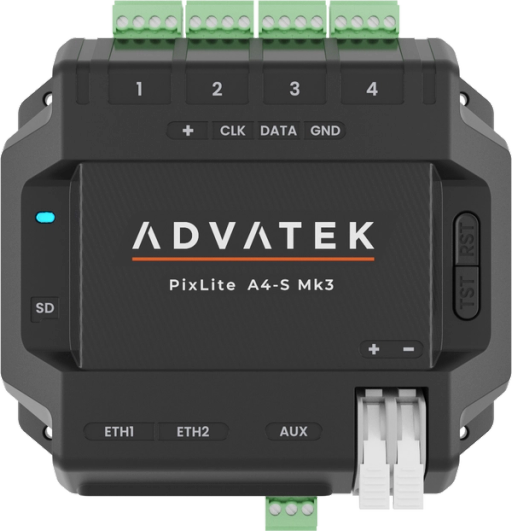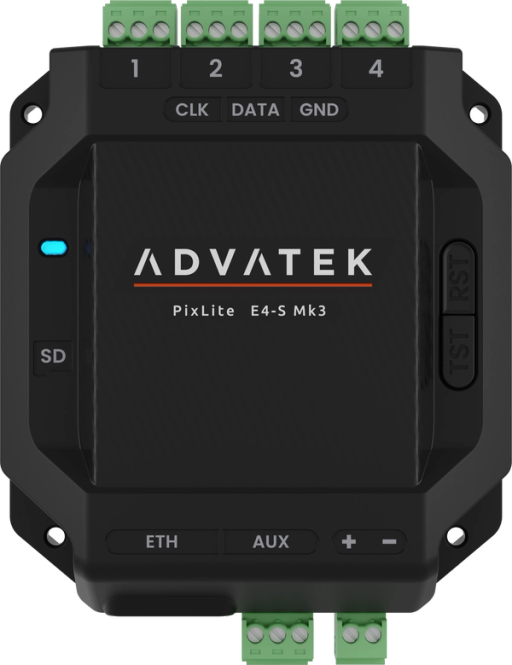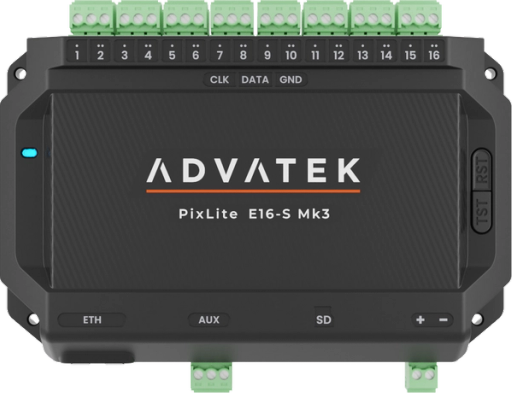Overview
This protocol was designed by Silicon Touch Technology Inc. in China. DM412 allows the connection of one RGB LED per chip and facilitates the chaining of multiple ICs to control RGBW LED sources. (i.e. four DM412 ICs can control three RGBW LEDs).
DM412 was specifically designed for LED video displays and lighting applications. Each channel provides 16-bits (65536 steps) of linear grayscale PWM control. The IC incorporates shift registers, data latches, 3-channel constant current circuitry with the current value set by 3 external resistors, and a built-in oscillator for PWM functioning.
Data, clock, and latch buffer outputs are used to cascade data to other ICs.
DM412 is available in SOP16/SSOP16/TSSOP16 and QFN16 form factors. The SOP16 package is shown below:

DM412 pixel protocol
Connecting to a PixLite Pixel Controller
The data and clock lines can be connected to the pixel outputs as per their pinout. There is an additional pin included on DM412 pixel IC chips, which is usually called “Strobe” or “Sync”. For normal operation, this pin must be connected to a 5V source, since the PixLite controller doesn’t implement actively driving this signal. This may already be implemented in the circuitry of DMX412 pixel fixtures. If there is not an externally accessible “Strobe” or “Sync” signal on your pixel fixture, it should be already connected to 5V internally. However, if there is an external signal available, this may need to be connected to a 5Vdc source if it is not “pulled high” inside the pixel fixture.
Specifications
PixLite Mk1 | |
PixLite Mk2 | |
PixLite Mk3 | |
Clock Type | Clocked |
Color Resolution | 16 Bits |
Current Control | |
Physical Package | SOP16 |
RGB | |
RBGW | * |
Input Voltage | 5V |
Output Pixel Voltage | 5V |
Redundant Data Line |
* RGB & RGBW Color Options
Some pixel fixtures cascade the output of multiple three-channel ICs on a PCB to drive four-channel LEDs. For example, four three-channel (e.g. RGB) ICs can be wired together to control three four-channel (e.g. RGBW) LEDs. PixLite Mk3 supports this by offering an RGBW color option for this protocol.
Considerations for Use
Advantages
- Presence of a clock allows for faster refresh rates
- 16 bits of data for each color makes dimming curves very smooth
Disadvantages
- This IC can only be powered from 5V. The relatively low 5V input will limit cable length between power supply and pixel fixture, unless the pixel fixture includes a DC-DC converter circuit to enable a higher input voltage.
- The Strobe/Sync line of this protocol may require the user to make a direct connection to a 5V power source when used with PixLite controllers, depending on the pixel fixture’s design, as described above.
- No redundancy in data
Need Help with Your Next Project?
PixLite Support
Are you looking for DM412 pixel drivers that work with Art-Net or sACN?
All PixLite Mk3 products support DM412 as an available Pixel IC type, so get in touch with us to find out how the lighting specialists at Advatek can support you in your pixel lighting project.

PixLite® A4-S Mk3
Driving up to 24 universes of data, and offering easy mounting, sleek design and electrical fault protection — what’s not to love?

PixLite® E4-S Mk3
The E-series LED pixel controller is made for tighter budgets thanks to its ability to drive up to 24 universes of LED pixel control and route power directly to LEDs.

